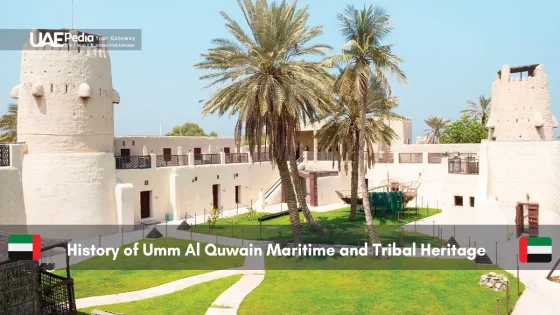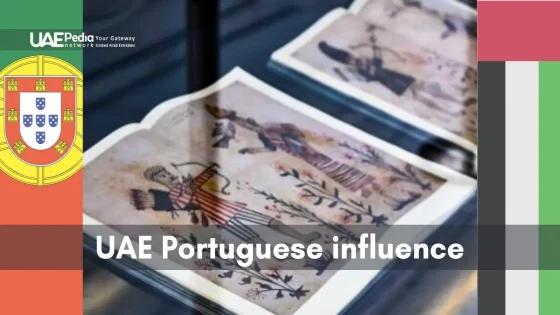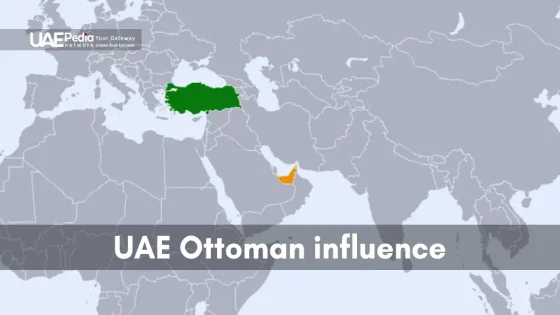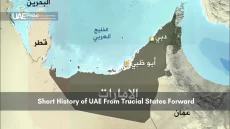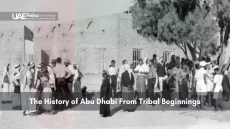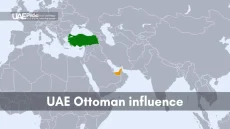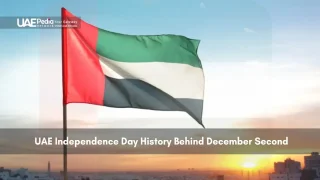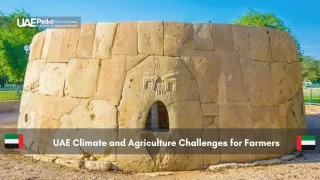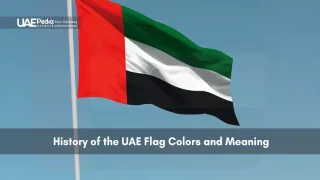Did you know one of the UAE’s smallest emirates holds secrets of pearl divers, desert tribes, and clay artisans older than skyscrapers? This coastal gem—tucked between mangroves and dunes—reveals how land and sea shaped a community’s DNA long before modern borders existed.
Here, crumbling forts whisper of Bedouin resilience, while pottery shards washed ashore hint at trade routes linking Arabia to distant ports. The United Arab Emirates often dazzles with futuristic cities, but UAQ’s charm lies in preserving traditions like pearling techniques and palm-frond house building.
We’ll walk through restored mud-brick homes at the museum, decode symbols on 500-year-old jars, and explore why this location became a crossroads for caravans and dhows. You’ll discover how families thrived here using tidal patterns and seasonal winds—knowledge passed down like heirloom recipes.
Key takeaways:
- Coastal geography and tribal networks defined UAQ’s culture for centuries
- Artifacts from pearling voyages and desert trade fill the emirate’s heritage sites
- Modern restoration projects breathe new life into historic houses and forts
Exploring the Origins and Early Inhabitance
What if I told you this quiet stretch of coastline once buzzed with Bronze Age traders haggling over pottery and pearls? Long before skyscrapers, the emirate we now call Umm Al Quwain thrived as a crossroads of desert caravans and monsoon-powered dhows.
Ancient Settlements and Tribal Roots
Dig into the sand at Tell Abraq—a site dating back 4,000 years—and you’ll uncover clay jars that carried dates and fish sauce to Mesopotamia. Nearby Ed-Dur reveals stone tombs and Roman coins, proving this region traded with empires from Rome to India. “These finds rewrite our understanding of early Gulf culture,” notes a local archaeologist.
Maritime Routes and Early Trade Networks
Imagine 2,000 years ago: wooden ships hugging the coast, carrying frankincense to Babylon. The town’s natural harbor at Sinnayah Island became a pitstop for sailors riding seasonal winds. Tribal leaders like Sheikh Rashid bin Ahmad Al Mualla later harnessed these routes, building alliances through pearl diving and date farming.
Three clues reveal UAQ’s layered past:
- Charred date pits in fire pits show year-round settlements
- Indian Ocean cowrie shells found in Bronze Age graves
- Distinctive circular tombs aligning with stars
From clay tablets to coral-built forts, every artifact whispers how land and sea shaped this emirate’s DNA. Next time you stroll UAQ’s beaches, picture merchants unloading spices where herons now wade.
The Formation and Evolution of the Emirate
Picture this: a coastal settlement transforms into a sovereign power while empires rise and fall around it. By 1775, UAQ declared itself an independent sheikhdom under Sheikh Rashid bin Majid Al Mualla. Its strategic location near maritime routes and date palm groves made it a prize worth defending—often through shrewd alliances documented in tribal agreements.
Establishment as an Independent Sheikhdom
The Al Mualla family’s rule began with a dramatic 1820 takeover of the old fort—a sandstone sentinel overlooking the creek. Sheikh Rashid bin Ahmad later expanded trade networks, using pearls and dried fish to build diplomatic ties. Surviving letters show how he negotiated with British envoys while maintaining tribal autonomy.
Political Milestones and Ruler Lineage
Three markers define UAQ’s journey:
- The 1768 construction of its iconic fort (now a museum displaying artefacts)
- Inclusion in the 1971 union forming the United Arab Emirates
- Modern excavations revealing 18th-century tombs near the city center
Walk through Umm Al Quwain Fort today, and you’ll touch walls that witnessed secret treaties and monsoonal trade winds. Coral bricks here hold stories of Bedouin councils and monsoon traders—proof that small emirates can leave big footprints.
History of Umm Al Quwain: Maritime Legacy and Tribal Traditions
Ever stood where shifting sands kiss turquoise waves? In this corner of the arabian gulf, centuries-old rhythms still pulse through coastal villages and bustling markets. The culture here wears two faces—one shaped by pearl divers braving deep waters, another by tribes navigating dunes under starry skies.
Cultural Influences Across Land and Sea
Coastal sites like Al Sinniyah Island reveal stone foundations of seasonal fishing camps. Archaeologists found oyster shells piled high—evidence of pearl diving ventures that once fueled the region’s economy. “Each shell tells a story of risk and reward,” says a curator at UAQ Museum, pointing to 19th-century diving weights displayed beside tribal jewelry.
Three threads weave Umm Al Quwain’s identity:
- Dhows & Date Palms: Shipbuilders crafted vessels using methods detailed in maritime trade records, while inland families perfected falaj irrigation
- Stone Secrets: Geometric patterns on old houses mirror wave crests and dune curves
- Island Time Capsules: Ed-Dur’s artifacts include Roman glass alongside local pottery
Today, elders teach kids to read tides for fishing trips, just as ancestors did. Wander the city’s oldest quarter, and you’ll spot coral-block homes standing strong—testaments to a heritage that refuses to fade. It’s this blend of land and sea wisdom that makes the united arab emirates’ coastal charm so irresistible.
Unearthing the Archaeological Treasures
Imagine holding a Roman coin found beneath desert sands—a tiny time capsule whispering of ancient trade routes. This thrill defines Umm Al Quwain’s archaeological wonders, where every shovel scrape reveals layers of human ingenuity.
Discoveries at Ed-Dur and Tell Abraq
At Ed-Dur, dubbed the “Mother of Houses,” teams uncovered circular tombs containing Roman glass alongside local pottery. Just 15 miles west, Tell Abraq’s mound hides a 4,000-year-old trading post. “These sites prove our region was a cultural blender,” says Dr. Ali Al Mansoori, holding a charred date pit from a Bronze Age fire pit.
Artifacts, Pottery, and Ancient Relics
Inside the restored umm quwain fort (now a museum), you’ll find fishhooks made from stone and necklaces strung with Indian Ocean shells. Look closer: zigzag patterns on clay jars mirror waves in the nearby creek. These artefacts aren’t dusty displays—they’re snapshots of meals shared and monsoons weathered.
Three finds rewrite what we know:
- A 1st-century AD burial site with Frankincense resin
- Ceramic oil lamps dating back to the pre-Islamic period
- Fishing nets weighted with stones from Oman’s mountains
Today, the united arab emirates protects these treasures while inviting visitors to touch the past. That Roman coin? It’s displayed beside a pearl diver’s knife—proof that this location always connected continents.
Modern Developments and Cultural Revival
What if coastal traditions could fuel tomorrow’s economy? Umm Al Quwain answers this with a blueprint that pairs heritage preservation with 21st-century ambitions. Wander through the city today, and you’ll spot cranes rising near coral-block forts—a visual metaphor for progress rooted in history.
Economic Strategies and Vision 2021 Initiatives
The United Arab Emirates’ Vision 2021 framework transformed this once-sleepy emirate into a hotspot for sustainable tourism and niche industries. Sinniyah Island now hosts eco-lodges beside ancient fishing camps, while pearl-diving techniques inspire luxury jewelry brands. “We’re building bridges between old skills and new markets,” shares a local entrepreneur.
| Initiative | Focus Area | Impact |
|---|---|---|
| UAQ Free Trade Zone | Logistics & Small Biz | +18% trade growth (2023) |
| Sinniyah Eco Project | Cultural Tourism | Restored 4 heritage sites |
| Pearl Innovation Hub | Tech meets Tradition | 15 startups launched |
Preservation of Heritage Sites and Museums
At the 18th-century Umm Quwain Fort, laser scans now guide restoration of wind towers that once cooled pearl merchants. Down the coast, teams use 3D mapping to protect Ed-Dur’s tombs from rising tides. The emirate even revived pearl diving festivals—complete with traditional songs and net-mending contests.
Three ways UAQ honors its past while charging forward:
- Digital archives preserving Sheikh Rashid bin Ahmad’s trade agreements
- Artisan grants for palm-frond crafts and dhow building
- Night markets where elders teach pearl grading to TikTok teens
This isn’t just progress—it’s a dialogue across centuries. Next time you sip karak tea near the fort, listen closely: the whispers of pearl divers now mingle with the hum of electric tuk-tuks.
Final Reflections on an Enduring Legacy
What if ancient walls could share stories of pearl divers and modern dreamers? In this corner of the arab emirates, whispers of the past mingle with the hum of progress. From weathered tombs to lively markets, every alley reveals how a small emirate carved its identity between dunes and waves.
The journey from tribal councils to heritage site restorations shows a community honoring its roots. Elders still teach palm-frond weaving beside 3D-printed museum displays—proof that traditions thrive in new forms. Those Roman coins and oyster shell piles? They’re not just artefacts but roadmaps to understanding how this region shaped—and was shaped by—global currents.
Today’s city pulses with layered life. Wander the islands at sunset, and you’ll see fishermen using tidal wisdom passed through generations. The united arab spirit shines brightest here, where time feels both expansive and intimate.
Ready to trace these threads yourself? Let uaepedia.net guide your discovery of a legacy written in coral bricks and starlit souqs. Every visit adds new chapters to Umm Quwain’s never-ending story.
Its coastal location shaped a seafaring culture tied to pearl diving, boat-building, and trade routes dating back 2,000 years. Artifacts like pottery from Mesopotamia and Roman coins found at Ed-Dur reveal its role as a hub connecting Arabia to global networks.
Yes! Ed-Dur, one of the Gulf’s largest pre-Islamic settlements, features tombs, temples, and a sun temple. Nearby, Umm Al Quwain Fort—now a museum—displays weapons, tools, and pearl-diving gear that tell the emirate’s tribal and maritime stories.
Bedouin customs like falconry, camel racing, and date farming thrived alongside fishing. The Al Ali tribe, led by the Al Mualla dynasty since 1768, fostered resilience through seasonal migrations and communal majlis gatherings that still shape social bonds today.
Not yet, but Ed-Dur and Sinniyah Island (home to 1,400-year-old pearl-diving villages) are on the UAE’s UNESCO tentative list. Recent digs uncovered Iron Age tombs and stone houses, hinting at future World Heritage potential.
Initiatives like restoring the fort museum, hosting heritage festivals with dhow races, and Vision 2021 projects balance modernity with tradition. Even new developments often use coral stone and barasti designs echoing ancient architecture.
Absolutely! Visit the fort’s date-palm roof galleries, join archaeological tours at Ed-Dur, or watch artisans craft traditional dhows. Don’t miss the November Heritage Festival for live demonstrations of weaving, pottery, and Emirati storytelling.
